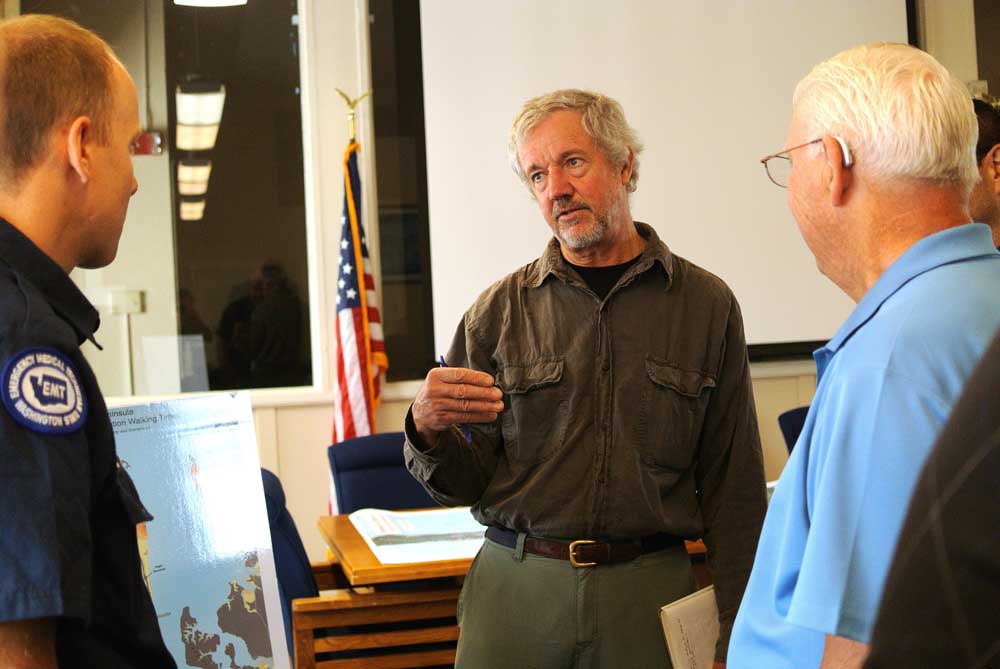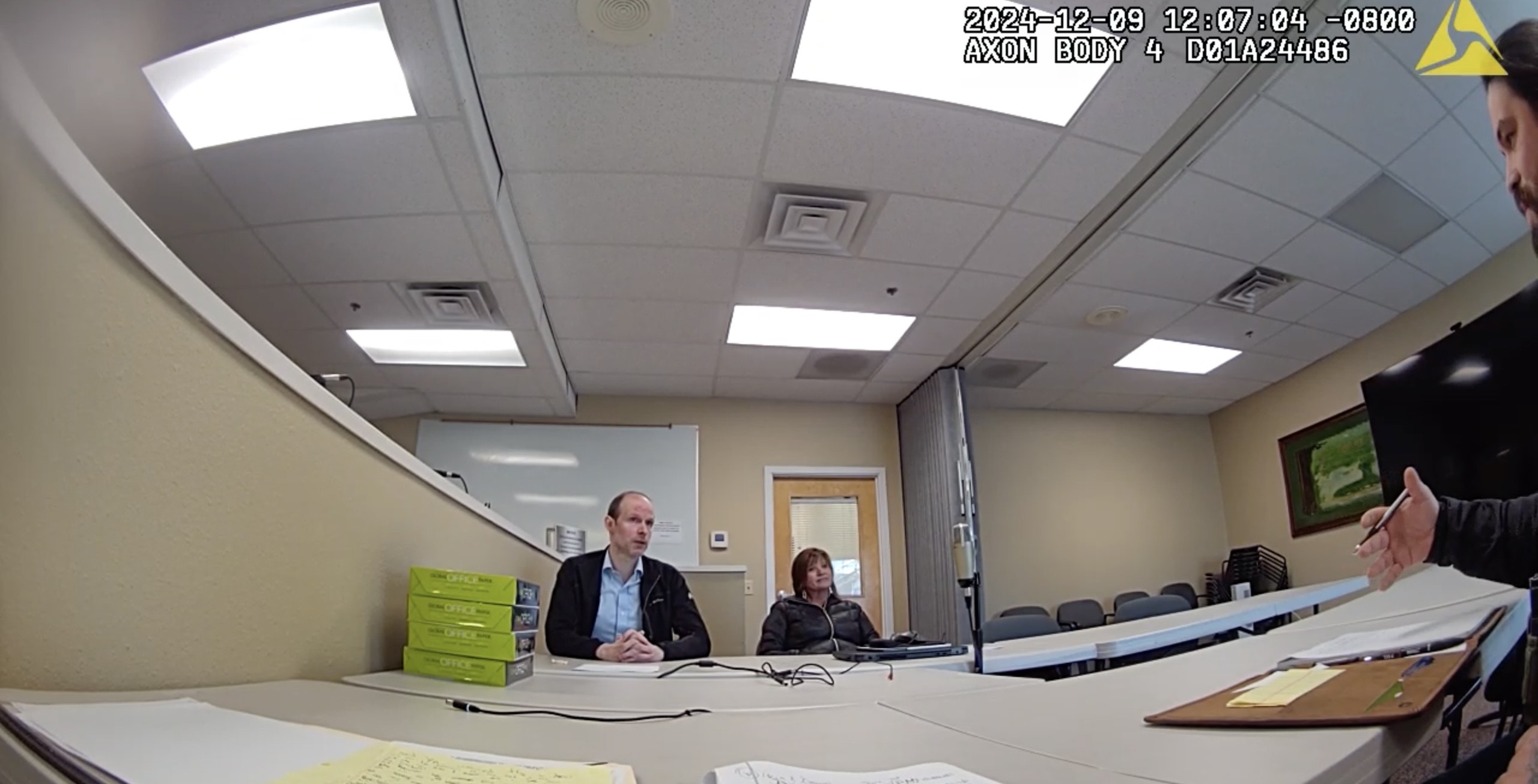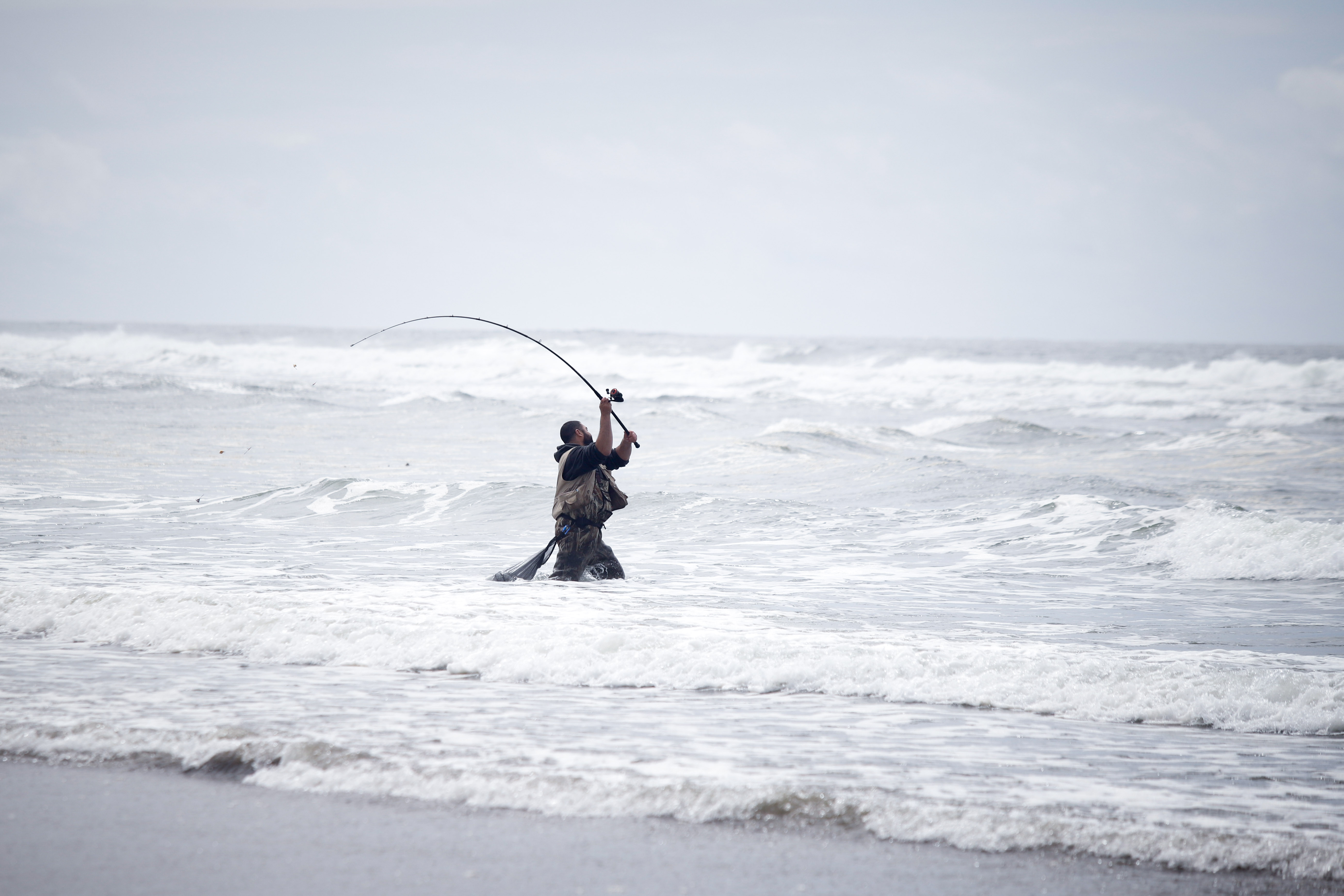Perfect Peninsula tsunami solution remains elusive
Published 12:31 pm Tuesday, July 26, 2016

- USGS geologist Brian Atwater talks to local officials at a meeting organized by U.S. Representative Jaime Herrera Beutler. “There's an urgency to it, but in some ways, geologically, there's time for people to proceed deliberately,” said Atwater about the Long Beach Peninsula's tsunami preparedness plans. There can be as much as a thousand years — or as little as about 240 years — between the megathrust earthquakes that Atwater discovered devastate the Pacific Northwest. The most recent one occurred in 1700.
LONG BEACH — U.S. Rep. Jaime Herrera Beutler met Friday with Long Beach city officials, Pacific County emergency managers, local first responders, a U.S. Coast Guard lieutenant commander and a U.S. Geological Survey geologist, to discuss what can be done to keep Peninsula residents safe in the event of a major earthquake and tsunami.
“What do we know? What needs to be done? How can we advocate?” Herrera pointedly asked the roundtable of concerned leaders.
As a member of the U.S. House Appropriations Committee, the congresswoman recently helped secure $10.2 million in additional funding for early earthquake detection.
Herrera also recently voted to approve the Tsunami Warning Education and Research Act that helps fund the state’s Tsunami Warning System. The program, managed by NOAA, improves tsunami preparedness, pays for tsunami modeling, and supports tsunami evacuation plans and implementation.
Herrera said she favors a high degree of local control over how federally allocated dollars should be spent. But judging by the vulnerability of local populations, a lot more funding will be needed, she said.
The congresswoman emphasized she was in Long Beach first and foremost to listen. And as she discovered, local officials were plenty willing to talk.
Long Beach City Administrator David Glasson introduced the city’s plans to build a vertical evacuation structure near Long Beach Elementary school that would serve as a viable escape route for hundreds of children and adults. (See related story.)
Glasson said the project relies on FEMA money, state-matched money and local funds, but is still about $1 million short of the $3.5 million needed to complete construction. He said building near the school made sense because of the concentration of children and also the density of the neighborhood.
Glasson said the berm-like structure would be the first of its kind in the nation. “To build the first one ever,” he said, “we’re setting the groundwork for everybody else.”
In an ideal world, Glasson said, structures similar to the one proposed near the school would be accessible to residents at a distance of every 2,700 feet, “to allow people to walk in the case of a tsunami.”
The native Quileute and Hoh peoples of the Pacific Northwest once spoke of a time when Thunderbird and Whale had such a terrible fight that the mountains shook and trees were uprooted. The ocean rose and covered the land and many villagers were washed out to sea.
But much like Japan’s ancient “tsunami stones” that quietly gathered moss at the high-water mark of long-forgotten inundations, the Native American myths became obscured through the foggy distance of centuries.
Now, as the crux of these ancient warnings are newly-resuscitated with the life support of modern science, the question is how local communities will add the literal high ground the flat area naturally lacks.
At 28 miles long, covering the entire Peninsula end-to-end in evacuation structures, not accounting for natural high ground, would require several dozen such projects.
But because of the prohibitive cost of such an endeavor, and taking into account pockets of natural high ground and areas of low density, Pacific County Emergency Management Agency’s (PCEMA) Chief Deputy Stephanie Fritts said 20 or more structures could effectively cover the bulk of the population clusters on the Long Beach Peninsula.
Project Safe Haven, she said, identified the key areas on the Peninsula in need of access to high ground. Fritts said plenty of funds have been directed toward science research, but the time is ripe for more money to go toward infrastructure investments that could save countless lives.
“Twenty years ago I asked for the scientific funding. I begged for it, because we needed the validation,” Fritts explained. “But we have way more than validated it. Now it’s time to have some actual application on the ground, in the community.”
After a nearby subduction zone quake ceases its initial violent shaking, authorities figure residents will have roughly 23 minutes to reach high ground. Currently, it takes a lot longer to reach a safe elevation from many locations on the Peninsula, Fritts said. Long Beach Mayor Jerry Phillips said that from some spots, it would take residents over 100 minutes to reach safety.
Fritts said no realistically obtainable measure will completely solve the issue, but the “berm” project could prove an invaluable starting point.
She said she would also like to see “the next structure” built near Ocean Park Elementary, and said she is excited Pacific County Fire District No. 1 is looking at a tower-type evacuation building. That project could be a city or a county-led endeavor, Fritts said, but added no funding is currently available.
Chief Jacob Brundage, of Pacific County Fire District 1, confirmed his support for the long-term goal of constructing a training center built to Safe Haven-standards on a property located between the fire station and Ocean Park Elementary.
With a $3 million to $6 million price tag for each vertical tsunami evacuation structure, enough for the Peninsula would cost well over $100 million, an astronomical sum for a set of small communities to come up with on their own.
If the Peninsula arguably needs several of these, Herrera asked emergency managers and city officials, “How many could effectively make a difference?”
“I know it’s a difficult question and I don’t mean to put you in an ethical dilemma, but stark realities do help move numbers in Washington, D.C.,” the congresswoman urged.
“What is a reasonable approach?” Fritts shot back. “Nobody’s able to answer that question.”
Don Zuern, a Long Beach public works official, gave the congresswoman a sense of some boots on the ground time it takes to get to high ground. From most of Long Beach, that is the hills east of Sandridge Road, “The fastest any of our crew guys have made it is 28 minutes,” Zuern said.
“And that’s a slow walk or a brisk walk?” asked Herrera.
“That’s acting like we gotta get there. It’s a pretty brisk walk,” Zuern said. “All the science is telling us 15 minutes. The fastest we can get there is 28 minutes, and these are grown-ups.”
Zuern pointed out to the congresswoman that there are often 300 kids at the school.
“So they’re not going to move as fast,” Zuern said. “That’s why this structure is so vital for our community.”
Scott McDougall, deputy director for PCEMA, did not hold back his opinion of the early-warning research that Herrera has found funding for.
“Would you rather put funding into something that’s going to give you 30 seconds to a minute-and-a-half warning, or would you rather put funding into something that gives you a place to go where you can get away from the water?” McDougall asked the congresswoman.
“Are you telling me we should be scrubbing that money and pulling it into this?” Herrera replied.
“I look at (early warning) as something that’s a penthouse item, and we’re not done building the foundation,” McDougall answered.
Scientists initially concluded Cascadia subduction zone quakes shook every 500 years on average. But recently, some Oregon State University geologists found a major earthquake occurred even more frequently; closer to every 240 years on the end of the fault off the south Oregon/northern California coast.
The last major Cascadia quake was 316 years ago, on Jan. 26, 1700.
Kenneth Murphy, FEMA’s regional administrator, told CBS News earlier this year that in the event of an 8.0 earthquake, casualty counts might reach 10,000 dead.
And that would be “a best-case scenario.”
When asked about a 9.0, Murphy said ominously, “We’re talking numbers that this nation, I’m not sure is really prepared to deal with.”
Then again, if you’re wondering how much to worry, it doesn’t help that scientists have pointed to the chances of a Cascadia megathrust quake occurring in the next 50 years at anywhere between 10 and 80 percent.
The science is also a little fuzzy on just how high tsunami waves might be when they encounter structures inland. This detail is vital when building vertical evacuation buildings, especially an open-air one like the proposed “berm,” which lacks a roofed enclosure.
Current “Safe Haven” standards are based on modeling of a 9.1 quake that expects a wave height impact of 22 feet at max. The proposed structure would rise to 35 feet above ground level and to 51 feet above sea-level.
Some recent modeling by Dr. Christopher Sabine for NOAA, now suggests that shoreline wave heights could reach 65 feet or more, and also that subsidence could sink coastal lands by more than 10 feet. Wave heights typically diminish as the wave loses power as it travels inland, but researchers say its hard to know exactly what to expect.
U.S. Coast Guard Lt. Cmdr. Tony Keene, who also serves as the USGS regional contingency planning chief, said that in the event of a major tsunami his personnel will be down, but not out.
Keene said all units from the 13th district that guards all of Oregon and Washington coasts are currently poring over after-action reports and damage assessments from the Cascadia Rising readiness drill completed in mid-June.
The commander’s words to the congresswoman were brutally frank.
“Honestly, for all of our coastal units, based on the damage assessment, you’re not going to have any Coast Guard boats and aircraft unless you happen to have one in the air at the time of the incident,” Keene said.
The lieutenant commander said he expects Cape Disappointment guardsmen themselves will have only about 15 minutes to get to high ground once the violent shaking stops.
The logistics of getting onto a boat, firing up the engines, and launching the vessel, said Keene, simply can’t be done quickly enough.
“You can’t get upriver far enough or out to sea fast enough to put a boat out safely so that you can do anything with it,” Keene said.
“So you’re just going to let it go? asked Herrera.
“You have to let it go, and save the people,” Keene answered. “You have to save the people, because without the people with the local-area expertise, you don’t have anything.”
Keene is looking at a plan to evacuate personnel to a long since decommissioned gun emplacement of reinforced concrete. But that project will likely take years to complete. Nevertheless, the high ground is there, Keene said, and that is an asset that some on the Peninsula will surely lack.
The lieutenant commander said crews won’t be able to react for at least 24 hours as multiple waves and aftershocks would likely make any rescue effort impossible. But he said personnel will be coming down into the communities to start rescue and recovery work as soon as possible.
He sees the construction of tsunami-proof structures as a potential life-saving tool that may also give rescue crews advanced awareness of sites where they know people will gather allowing for a more effective response.
“You just can’t hit hundreds of areas,” Keene said. “It becomes an issue of scale and numbers.”
With the enormous costs of constructing potentially dozens of tsunami berms or towers, city and county officials made clear they would like to see their congresswoman continue to work on securing tsunami readiness and tsunami structure-related funding. Enthusiasm for early-warning measures were more tepid.
The current gap between the enormous level of funds needed to protect residents, and their current state of vulnerability, presents officials at all levels of government with a sizable moral and financial conundrum.
“We simply can’t predict anything, all we can do is look at what’s happened in the past,” said George Crawford, a retired geologist with Washington Emergency Management.
He agreed with Fritts, who said early warning is helpful for urban areas, but less effective on the coast. “For these folks here, early warning, forget it,” Crawford said.
Brian Atwater, the USGS geologist whose research confirmed that megaquakes rocked the Northwest in the past and will certainly strike again, sat listening for most of the hour-long session. He said as far as coastal communities are concerned, the earthquake itself is the practical warning to evacuate.
“But there has to be high ground to move to,” Atwater added.
After the meeting Herrera reflected on the main lessons learned. “It’s all about high ground, and it’s about capacity at high ground,” she said.
Herrera said she wants to continue to find more money for local projects at the national level, and will also seek to team with allies in neighboring states and across the region.
Tsunami strategies on the Long Beach Peninsula are one thing, Herrera said, but getting the job done in D.C. is another. “It’s about how many people I can get to help me pull on an issue.”
After a quick tour of the grounds where the “berm” is slated to be built, the congresswoman walked briskly to a minivan parked alongside the school where her husband and children were waiting.
Herrera’s daughter ran through the grass in the shadow of the school and leapt into her mother’s arms. Her husband appeared with their infant son.
“Now who wants to go to the beach?” the congresswoman asked cheerfully.





